The Columbia Riverkeeper
Columbia River Basin
|
NEW ESRI StoryMaps: What's On Our Shelves & NWNL Song Library & No Water No Life ESRI |
Columbia River Basin
Brent Foster
Columbia Riverkeeper Executive Director & Attorney
Alison M. Jones
NWNL Director and Photographer
Riverkeepers is a global organization with 10,000 members and supporters. As Columbia Riverkeeper, Brent works with Tribal Nations to support salmon as a keystone species. He’s used his background in law and social justice as springboards to address overextraction of water, habitat destruction and water pollution. His success in combining a law career with environment activism should show us all that we too can use seemingly non-related skills to help improve and protect our urban and rural water quality for the sake of all.
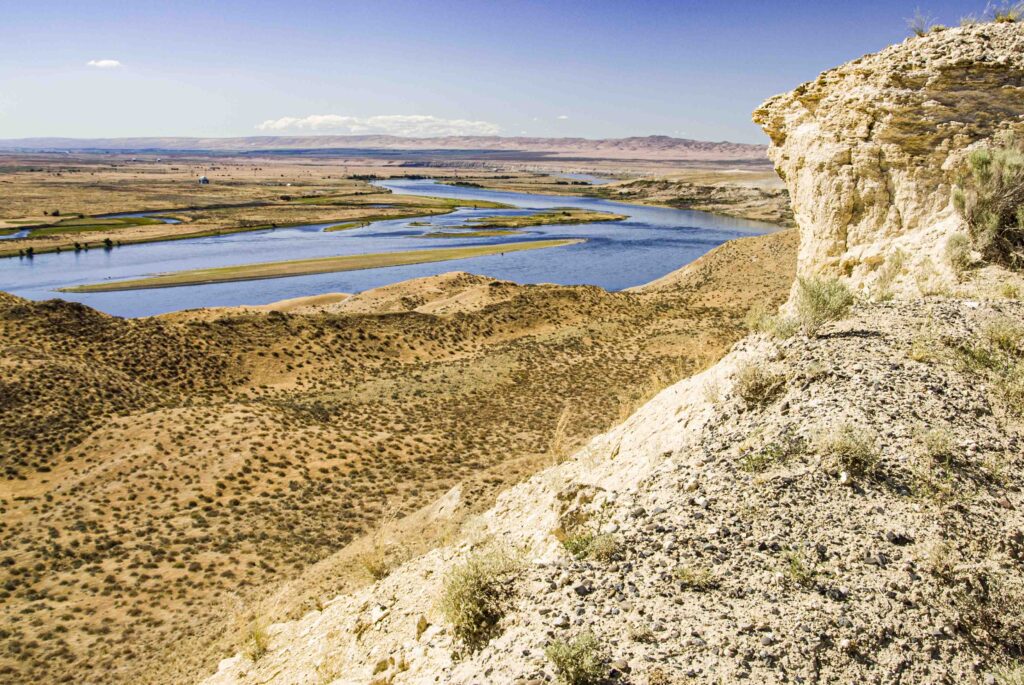
COLUMBIA RIVER VALUES & FUNCTIONS
OUR HUMAN FOOTPRINT
DO HATCHERY SALMON HELP?
SALMON & COLUMBIA BASIN TRIBES
DAMS
WARM WATER & CONTAMINANTS
RIVER POLLUTION
HANFORD NUCLEAR SITE
CLIMATE CHANGE
URBAN INFRASTRUCTURE & ZONING
LOOKING FORWARD, TOGETHER
OPTIONS FOR HANFORD – UTOPIAN?
STEWARDSHIP – EVEN TRANSBOUNDARY!
WATERKEEPERS’ ALLIANCE
BRENT FOSTER’S VISION
THE COLUMBIA PLUME AND DEAD ZONES
TREE LOSS – MINING MINERALS – DAMS (again)
INTERNATIONAL STEWARDS AS SUPPORT
All images © Alison M. Jones, unless otherwise noted. All rights reserved.
NWNL Brent, you have a great job on a great river! What previous experience led you to becoming Columbia Riverkeeper?
BRENT FOSTER For 4 or 5 years, I was attorney for Columbia Riverkeeper years. I initiated litigation enforcing the Clean Water Act and worked to stop uranium shipments to Hanford Nuclear Site. I became Executive Director 2 years ago, thinking working twice as much for half the pay was a great idea!
NWNL It seems your legal background supports the job of watershed stewardship?
BRENT FOSTER It helps a lot. The river is run by laws, whether they focus on flows, pollution or healthy fish populations. All such issues are directly affected by laws we make and their enforcement. For me, law is a tool for helping restore a river. It’s not the only tool, but it’s one tool.
NWNL The Columbia is a big river that crosses many boundaries, communities and ecosystems. How do you define the river’s value to its watershed ecosystems, flora, fauna and human populations.
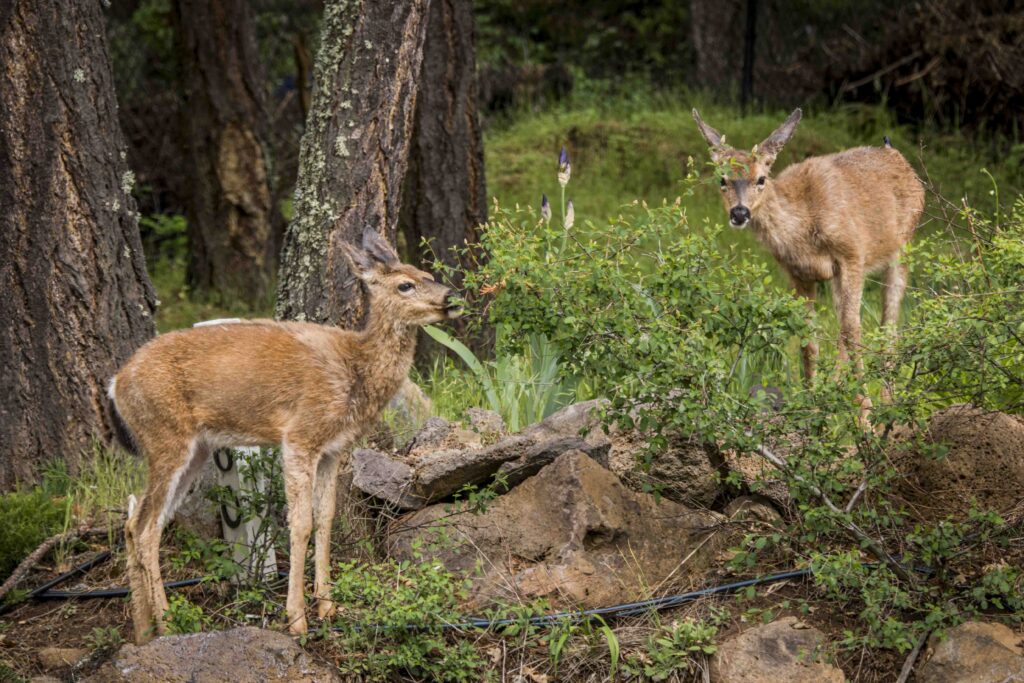
BRENT FOSTER It is a huge river that ties together hundreds of communities from its Canadian headwaters down to its mouth at Astoria and Cape Disappointment. The indigenous communities were the first and long-time occupants of the Columbia River Basin.
From tributary to tributary, the Columbia River ties together river communities, whether along the Hood and White Salmon Rivers right here, or a 7-mile salmon-spawning tributary in Oregon or wetlands in Canadian Rockies. Each tributary each has its own unique values. Whether a salmon spawning ground or great migratory bird area…, the Columbia River brings all tributaries together from Canada’s glacial waters to our famed Cape Disappointment at the river’s mouth. The Columbia’s largest tributary, the Snake River runs through its own huge basin full of incredible values and serious threats.
NWNL How have people used this river throughout the centuries since the Great Missoula Floods carved this basin and its waterways? How has this great river supported the people here, as well as the watershed’s wildlife and vegetation?
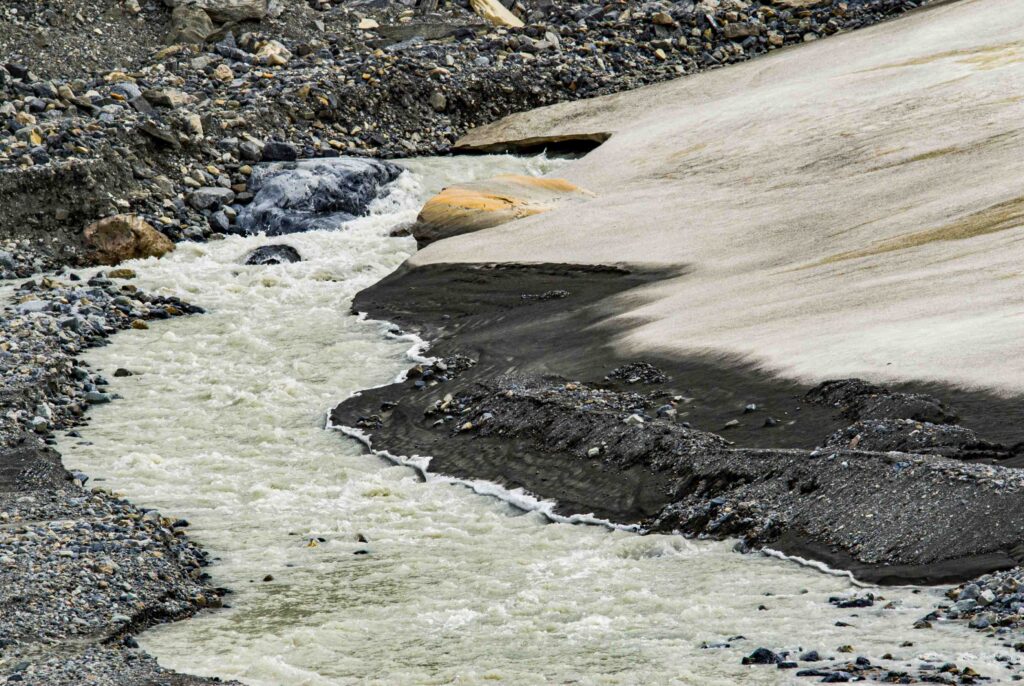
BRENT FOSTER It’s been said of the Columbia – and probably other rivers too – that “no river has been asked to do as much for humans.” There were early settlers relying on the river to irrigate fields; folks with goods transported by steamships; and then dam builders supplying power and powerful bombs. While the Columbia River dam system helped humans, it fundamentally changed the river. Our hydropower system has definitely been the most dramatic change.
BRENT FOSTER European-Americans took a wild river marked by amazing epicenters of native American activity. The river’s Celilo Falls, Kettle Falls and the Cascade Locks, near here, were productive bases for Native Americans who accepted the river’s wildness. But our dams tamed that wild river into a series of slack water lakes fundamentally change the Columbia. Historically, it might have taken a juvenile salmon a few weeks or less to migrate downriver from where it was born to the ocean. Now, with today’s dams, it takes juvenile salmon months to make that same trip; and every day on that trip is another day of exposure to predators, making it less likely they will reach the ocean.
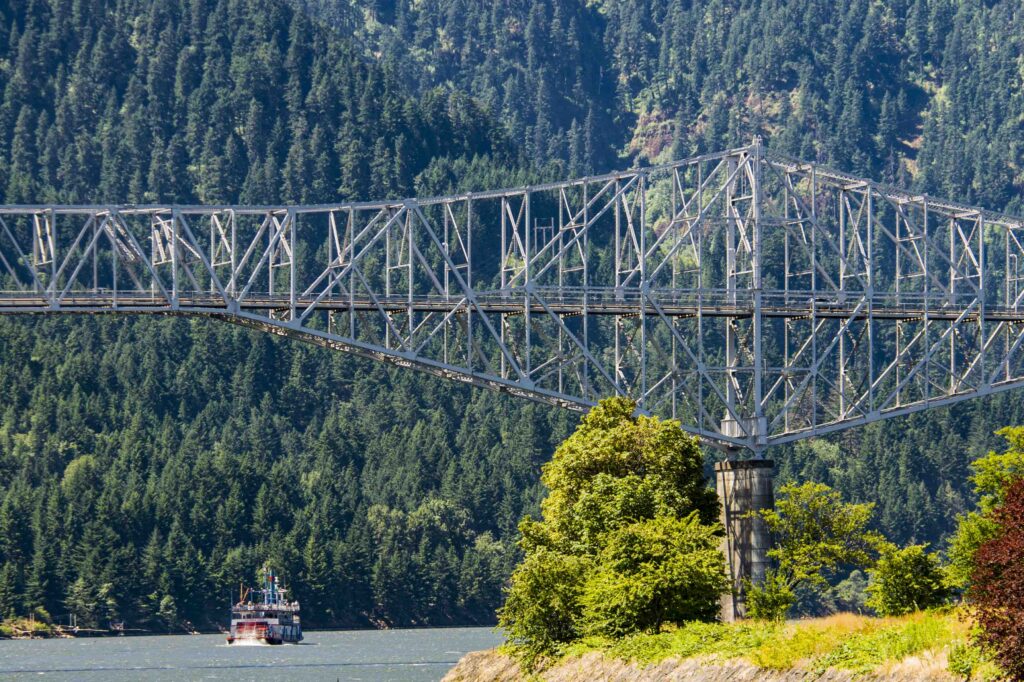
For thousands of years, there were annual monumental salmon migrations that passed through here. But now we’ve lost huge amounts of native salmon spawning habitat upstream in Canada. Salmon simply can’t get there past the dams. When they built Grand Coulee Dam, they didn’t want the expense of putting in a fish ladder. Thus, we entirely closed the Columbia’s flow into Canada, where salmon migrated for years, was closed.
NWNL Do you have data on salmon numbers before versus after the dams that caused the loss of fish habitats, warmer water and other stressors?
BRENT FOSTER A couple problems mask the full extent of today’s salmon crisis. We now have only 10% of former salmon migrations, but due to our massive hatchery program, we still have significant numbers of salmon.
NWNL So only 10% of the earlier salmon population is still on the Columbia?
BRENT FOSTER Right. Stories are really the best indicator of just how thick the salmon were. Native Americans still talk about the times when they could walk over the backs of the salmon from one side of a stream to another! They say that when driving horses across the river (once European settlers showed up), there were so many salmon that the horses would freak out.
If you’ve seen a great salmon run in Alaska, you can understand. But we don’t see those thick runs coming back here now. There are runs today, as in Wyoming’s Wind River, with only about 100 wild steelhead. Given a few bad years, they will be extinct. I’ve snorkeled that river to do salmon counts. The abstract concept of extinction is scary and concerning; but my knowing the numbers and then seeing such a tiny run of salmon in person affected me so much more deeply.
BRENT FOSTER Recreational anglers and tribes can still fish salmon. But they catch mostly hatchery salmon. If hatcheries closed tomorrow, we’d see a dramatic crash, because these hatchery fish are just mechanically collected, artificially raised in big ponds, and then released. They don’t spawn to produce future generations.
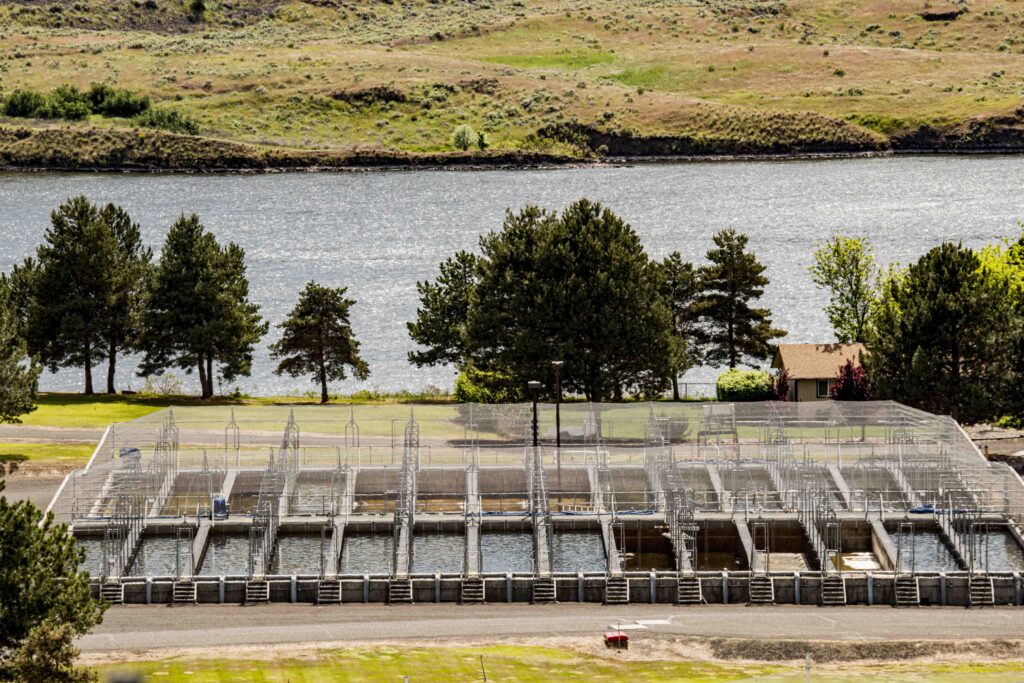
NWNL What percentage of salmon are now hatchery salmon?
BRENT FOSTER Only 10% are wild salmon. The other 90% can’t survive in the wild, so aren’t self-sustaining. The Endangered Species Act didn’t expect we’d be managing a zoo population.”
NWNL What is the average life of a wild salmon before spawning and dying?
BRENT FOSTER It depends on the species.… After hatching, salmon fry remain in fresh water as juveniles; then go down to the Columbia Estuary to buff up a little on their size; and then enter the great big ocean. They spend several years there, absorbing ocean nutrients and growing bigger. Typically, they return in 3 to 5 years.
NWNL What part of that life cycle is most vulnerable for hatchery salmon?
BRENT FOSTER Well, depending on where and when they are let out from the hatchery, they must make their way down to the dams, which are deadly for salmon. Every main stem Columbia and Snake River dam kills about 10% of the salmon that pass through. Many people think the biggest problem regarding dams and salmon is that they cannot get over the dams; yet many lower dams have fish ladders for them. But coming back downriver, they must run through the dams’ turbines. That’s like running through a blender. As juveniles swim down through dam, after dam, after dam, a big percentage are lost.
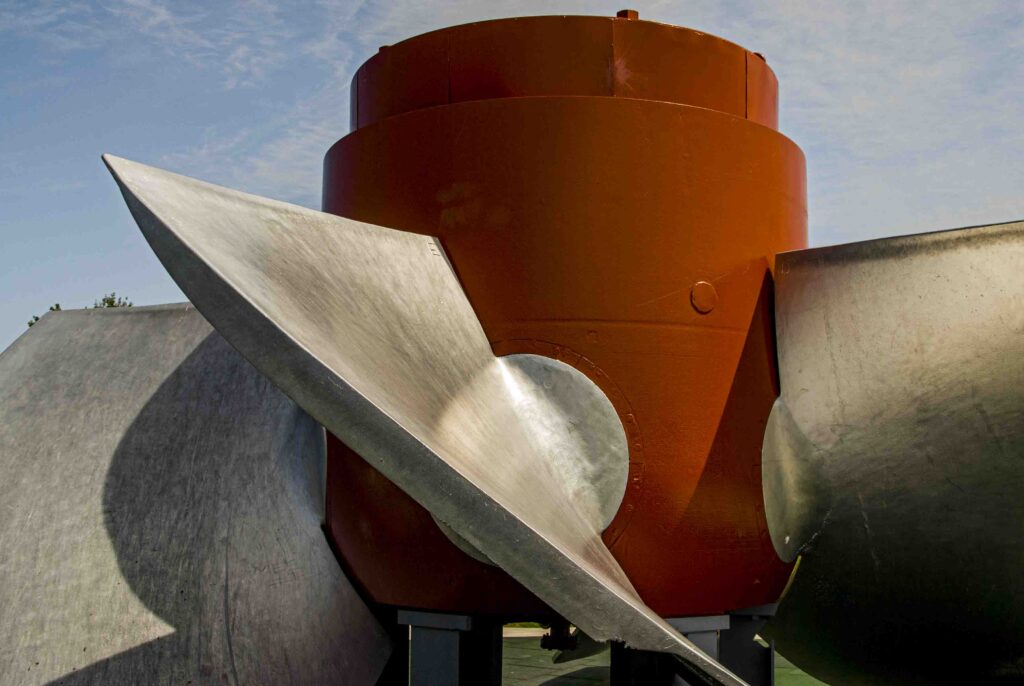
NWNL One dam I visited is redesigning their juvenile bypass with new technology. Will that help?
BRENT FOSTER It’s good to try to anything. For 30 years they’ve tried new salmon technologies. They tried barging. They spent $50 million on a new juvenile bypass at Bonneville. They tried killing predator fish that eat salmon. Those efforts didn’t do much. The approach they haven’t accepted is the easiest and guarantees more salmon. That is for the dams to spill more water.
Riverkeepers and others sued several years back, requesting they spill more water. The judge agreed and, under the Endangered Species Act, ordered more water be spilled. This increased juvenile salmon survival by 60% in one year! After the first year, the judge made them do it again, but that was last year.
The US government will do almost anything to keep producing as much power as possible, so they say, “Increasing flows won’t help fish.” But when finally forced to do so, 60% of the juvenile salmon returned; yet the U.S. Army Corps of Engineers and Bonneville Power Administration howled about the wasted waters flowing downstream – the water that carried salmon over the tops of dams. Even when the Fish Passage Center reported spills boost salmon survival rate, Sen. Larry Craig from Idaho tried to block all its funding and basically killed the Agency.
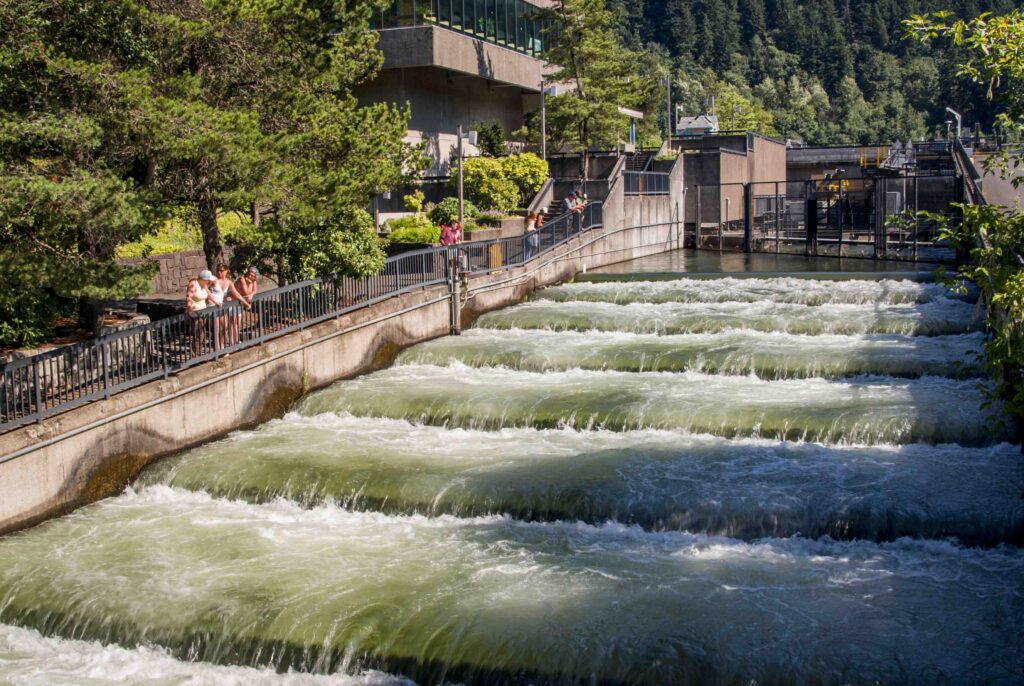
NWNL These salmon issues affect other populations, perhaps even including humans?
BRENT FOSTER All that impacts salmon impacts native tribes. For over 10,000 years on this river, salmon and tribes have been interlinked. When we destroyed the salmon, we buried Celilo Falls [now replaced by the Dalles Dam]. That loss was akin to a massacre on an entire tribe. They still have a spiritual connection to salmon, and eat fish from this river despite it, because they need it. It’s for the same reason that I swim in a polluted river – because I need to work to make the river clean.
The day the tribes stop fishing salmon is the day salmon will die, because there is a very close spiritual relationship. It’s an inspiration to help restore salmon. The tribes are big players in bringing back salmon.
NWNL They’ve been very active in legally, haven’t they?
BRENT FOSTER The tribes are doing valuable restoration projects. It’s been very interesting to see teen suicide levels decrease where they’ve done salmon restoration. We’re seeing a re-emergence of native culture in the youth and increasing use of the native language. Blocked salmon runs, buried falls, and river pollution had a very adverse effect on tribal youth. Conversely, bringing back salmon is producing a very positive effect on tribal young adults.
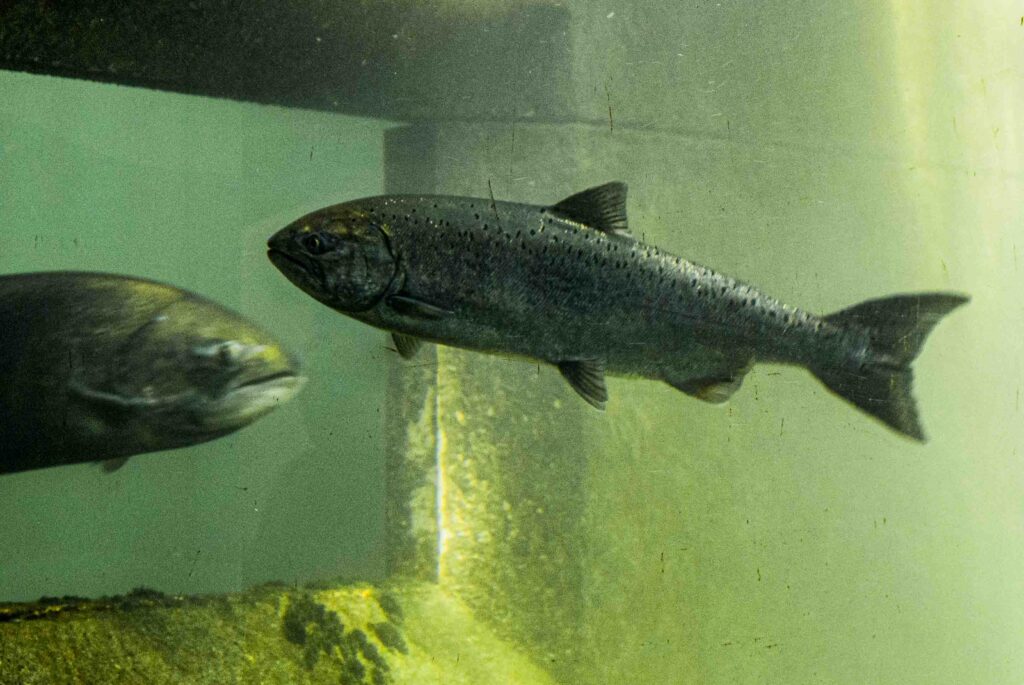
BRENT FOSTER I came to the Northwest to work on dam removal, big rivers and salmon restoration. It’s exciting to contemplate many dams coming down in the next 10-20 years, and the impacts to come. Success is possible.
NWNL What’s your laundry list of dams to come down? Both Marmot Dam on the Sandy River and the Condit Dam on the White Salmon River are due to come down. Are other dams on this list? Are any main-stem dams being considered?
BRENT FOSTER While none are planned on the main stem, the Lower Snake River dams are very high on everybody’s priority list, because they don’t produce much power. Their biggest constituents are farmers and barge operators in Lewiston, Idaho. They use the river as a navigable waterway all the way up to Idaho – but at enormous cost.
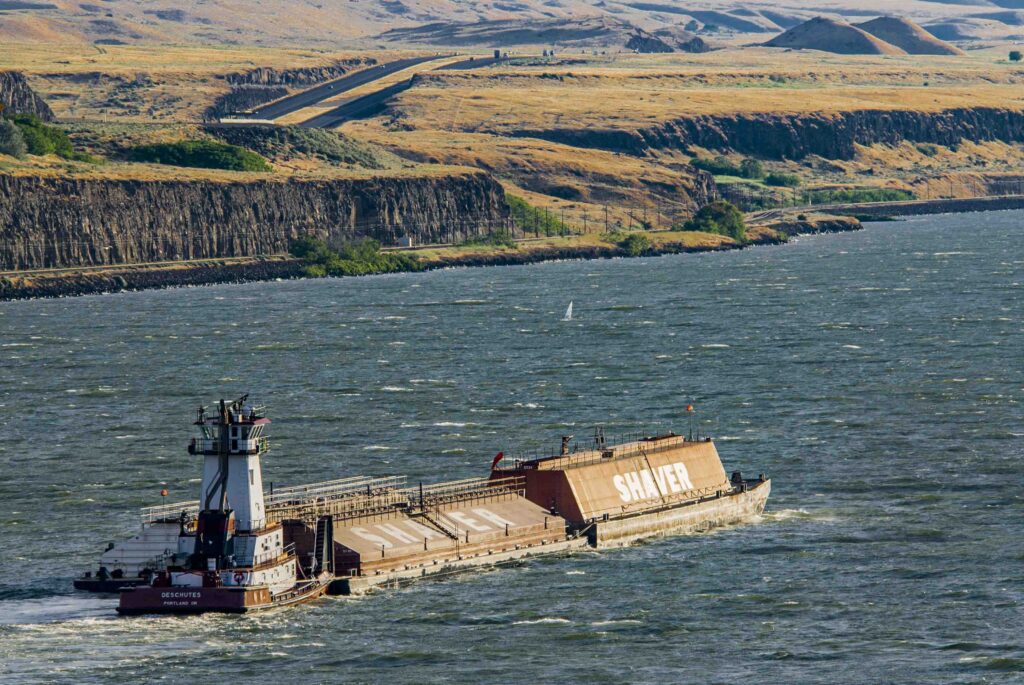
BRENT FOSTER Removing the Snake River dams will have huge benefits, but many other tributaries also have dams. So yes, for now, we’re waiting for the Condit and Marmot Dams to come out. Within twenty miles of here, in several directions, multiple dams on major rivers will be gone!
NWNL Brent, are their removals due to their inefficiency? Power companies say they’re unnecessary and cost too much to upgrade. If so, that’s not a commitment to dam removal or a free-flowing, wild river.
BRENT FOSTER I don’t care. I just want them to yank out those dams.
NWNL If your dream is to remove all the dams, will you just wait out the technology and make sure they don’t rebuild?
BRENT FOSTER We can restore salmon without removing all the dams. There may be valid reasons to keep some of the dams. I think Columbia River salmon could survive if there were only 3 or 4 main-stem dams, instead of 8. If we reopened the Upper Columbia River, we could bring salmon back into Canada. Around the country, many old dams eventually will come out, given that every dam has a finite life – especially because early dam builders didn’t think to include fish passage.
NWNL What goes wrong with dams?
BRENT FOSTER There is a range of issues. A concrete dam can lose its structural integrity. Restoration is critical in lower tributary rivers with dams, like the Sandy, Hood and White Salmon Rivers. The Condit Dam was built in early 1900’s when they were rolling out the Model T. So now, it’s time for it to go.
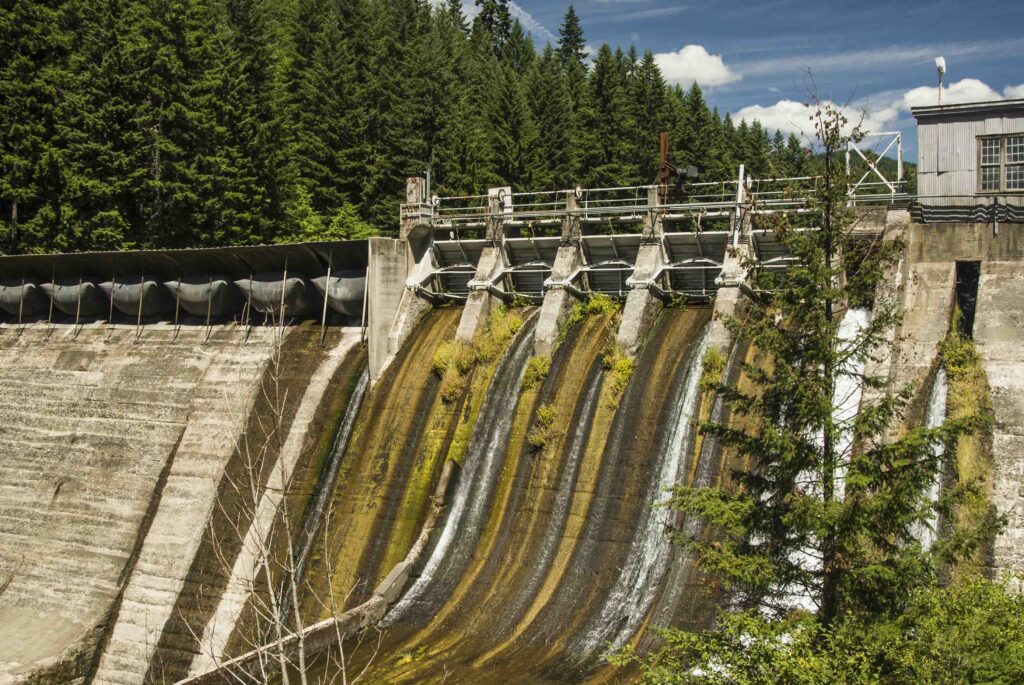
It’s great these rivers’ dams are set for removal because those tributaries are extremely important salmon spawning streams. Plus, they are below all the major dams, so the salmon swimming up these rivers have only one dam to get through. People will see that when we remove a dam, good populations of salmon come back quickly. Then they’ll realize the economic benefits of removing dams, including increased tourism for fishing. Fishermen visiting Alaska spend something like $1,000 per fishing day. It’s an incredible. Hundreds of people in Juneau, Alaska gather to line the banks on main salmon streams as the fish come. So, local communities see dam removal as an economic benefit – and that’s great. Let’s make dam removal projects the “pork” that Senators and Representatives want to bring home.
NWNL Neither the giant Grand Coulee nor Chief Joseph Dams have fish passage. Opening those dams would be very expensive. And today’s politicians are aware of global warming, which could mean salmon won’t survive in tomorrow’s warmer water. So they ask if such efforts would be worth the money.
BRENT FOSTER I’m highly confident the salmon will survive. All Columbia Basin streams are warming to some extent since our dams create bathtub-like situations in their slow-moving reservoirs that suck up solar radiation. So, to keep the Columbia viable for salmon, we must remove some dams to compensate for anticipated increased solar input.
People ask, “If we take out dams, where will we get that power?” Yet, for 30 years, the U.S. has avoided any serious study of energy efficiency conservation. Our cheapest and most environmentally friendly power is through increased efficiencies. With some federal and state subsidies, we could easily and massively decrease our overall energy use.
NWNL Continuing to address warmer waters, much river vegetation has been removed. Shade canopy along the riverbanks has been replaced development and industry along riversides. How does that impact salmon?
BRENT FOSTER Water temperature increases due to loss of riverbank habitat happens mostly along tributaries. Even if all Columbia River shorelines were lined with 250-foot-tall trees, it wouldn’t greatly warm the main stem. I’d like more trees there, but it’s more important to put trees along tributaries, especially those hammered by cows and agriculture. It’s also critical to aggressively buy riparian borders to become public easements.
To me, riparian corridors are well worth paying for. But’s been a controversial issue. It seems we don’t want to give farmers or other people subsidies to protect our environment. But it needs to happen, now and quickly. We must find the money.
NWNL What other urgent issues are you studying? For instance, how do you assess pollution and contamination?
BRENT FOSTER Columbia River has serious contaminants. A few years ago, EPA addressed how this contamination affects our indigenous tribes. Many tribal members here regularly eat fish, using all parts. A 2002 EPA fish-toxicity study, published with Columbia River Intertribal Fish Commission, found a 1-in-50% cancer risk for tribal members eating fish due to high DDT and PCP’s levels. Despite being banned for 30 years, both are still in the river. Yet some DDT levels are now lower in bald eagle eggs.
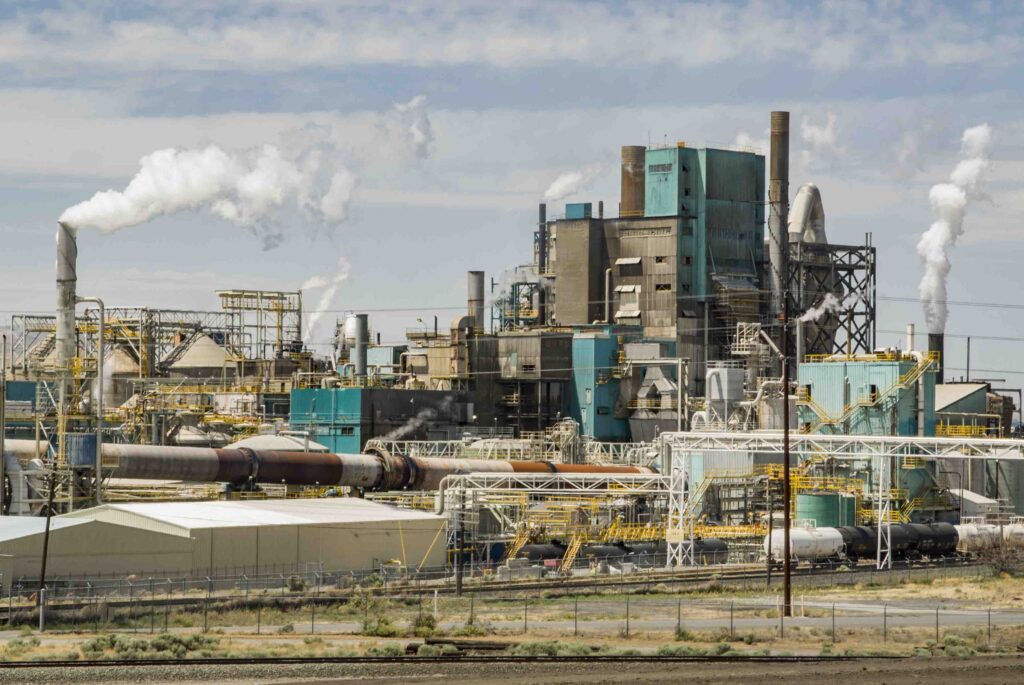
Much of today’s Columbia’s pollution comes from just 29 large dischargers. Oregon and Washington permit 167 billion gallons of pollutants in the river annually. With paper mills as big offenders, Portland spews 93,000,000 gallons of sewage per day. Many industries lack their own pipe into the river, so they just send it to the city.
NWNL What options are available for such wastewater?
BRENT FOSTER There are many ways to reduce toxic wastewater. The best is to use less toxins and invest in technology. Computer manufacturers used chemicals to clean circuit boards until they learned to use a cleaner based on lime juice. We’ve radically lowered pollution levels with new technologies. And electro-coagulation can suck heavy metals out from effluents, so we can dispose them as solid waste. We still have toxins and heavy metals, but now they’re not going into the river. If we do find pollution violations, we can use enforcement lawsuits.
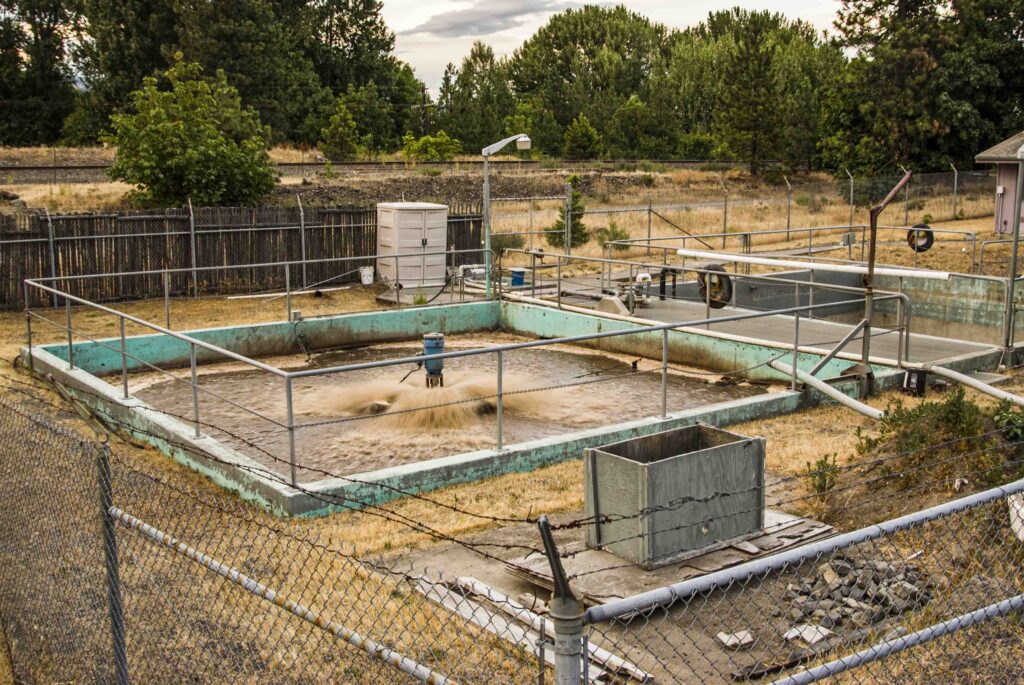
NWNL In discussing pollutants, we must include Hanford Nuclear Site, which was situated right on the Columbia so its waters could be used as coolants?
BRENT FOSTER Hanford is a huge hodgepodge of pollution covering 180 square miles on both sides of the Columbia River. Many people worry about Hanford, asking, “What if there’s a spill someday and radiation leaks into the river?”
Well, currently radiation does leak into the Columbia River from Hanford. Daily, heavy metals, including uranium and strontium, leak into the river. So it’s not a matter of “if” it happens.
Hanford Nuclear Site is a major, serious source of pollution, well documented by Dept. of Energy. Depending on whom you ask, they’ll say there’s no pollution problem. My response is, “I have a 4’-high stack of Dept. of Energy reports clearly documenting they still have a problem with uranium.” They say, “We don’t think uranium is migrating to the river. We think it is non-mobile.”
Non-mobile is the term they use to say they are not going to clean it up. They call their strategy for this highly toxic and radioactive uranium monitored natural attenuation. When I asked about this, I was told they’ll watch whether this stuff naturally flushes into the river – or stays to break down over the next 2 billion years.
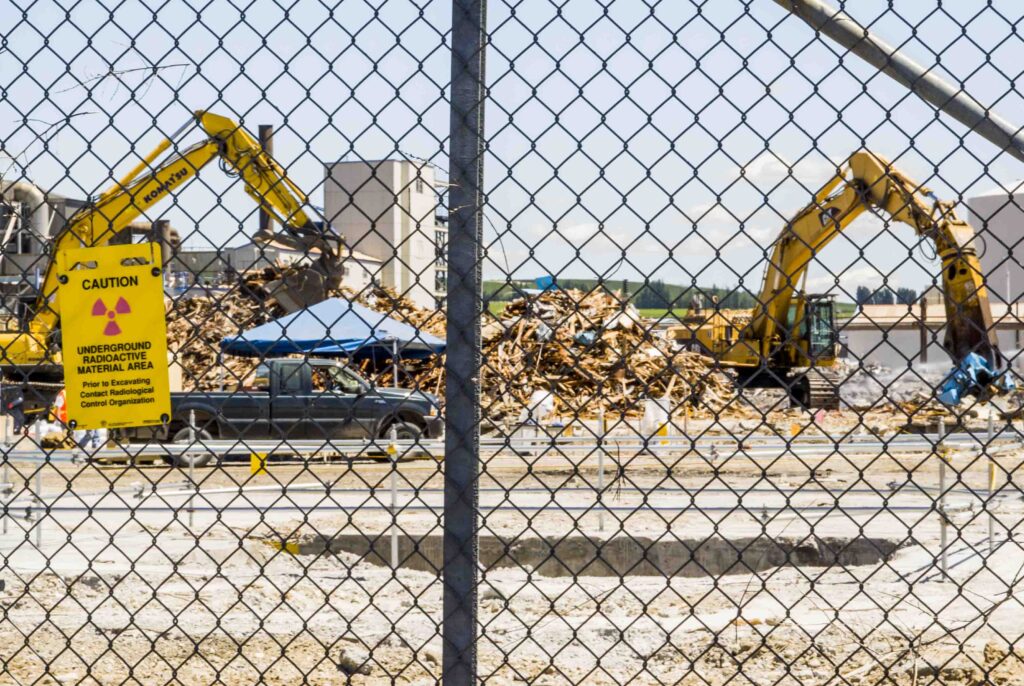
Hanford’s approach is crazy. We reached one agreement for some monitoring. A few years later, they admitted their mistake, saying, “In fact, it is migrating into the river.” They had found uranium in freshwater clams along the river.
So, at Hanford, arrogance and ignorance are combined. Since they didn’t want to spend money, they left their radioactive waste untreated. The cost of that decision showed up in clams – and certainly many other species. Historically, Native Americans have always eaten these clams. I think most now know not to eat clams near Hanford. That said, they miss the loss of clams and use of the river that was there for 10,000 years. Now it’s gone.
Further downstream, new immigrants coming to Portland from Southeast Asia regularly eat our clams now contaminated with PCB’s and other toxins. Native Americans know that the Hanford Reach is polluted, but Portland newcomers, needing food for their families, go to the river, saying, “Hey, Asian clams! These are something we know.”
NWNL Have there been related health problems in those communities?
BRENT FOSTER The U.S. Army Corp of Engineers has known about this problem for over a year. A couple weeks ago, they finally posted a warning not to eat the fish. Unfortunately, it’s very hard to document toxins from eating food from the river. There is no control group. And if you tell a doctor you’re sick, it’s unlikely he or she can connect it to river contamination.
NWNL How quickly can river flows dilute Hanford’s pollution?
BRENT FOSTER To some extent, dilution is the Columbia’s savior. With a lot of water, dangerous toxins become less toxic. But even so, toxic concentrations bio-accumulate. Strontium can accumulate up to 10,000 times in the river. Even in low amounts, strontium has a strong affinity to bio-accumulate. A continuing source of strontium will concentrate in invertebrates that fish eat, causing strontium levels in fish of up to 10,000 times above drinking water levels. For a long time, the theory for treating waste was, “Dilution is the solution to pollution.” Thirty years later, we know that cute saying isn’t the case. We can dilute all we want; but, if pollutants bio-accumulate within our food chains, we’ll keep seeing these effects.
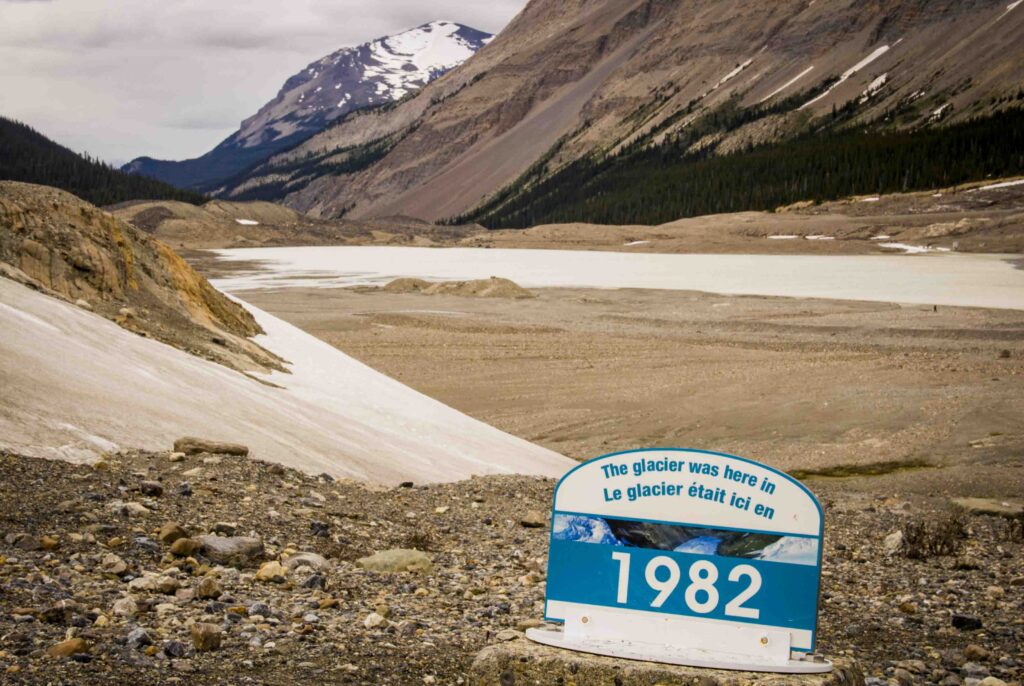
NWNL Returning to climate change issues, what evidence you see, read or hear about recession of the glaciers feeding Columbia Basin headwaters? Have water amounts that come off the glaciers into the Columbia River peaked? If so, will river flows diminish and thus diminish the anti-pollution powers of dilution?
BRENT FOSTER In any direction in the Columbia Basin, we see the impacts of glacial recessions. They provide critical summertime water for many key salmon-spawning streams. Salmon are the Columbia’s charismatic species; but we have frogs, turtles, aquatic insects, wide varieties of non-salmonid fish, migratory waterfowl, songbirds and other species that in many ways are tied into the same ball of wax facing salmon. In a healthy ecosystem with healthy tributary streams and a free-flowing river these species – even freshwater clams – can thrive. But once that trophic cascade breaks down, we see problems of a large-scale loss of species across the board. Granted, a few species do better in big reservoirs, but they’re not the norm.
For the most part, native ecosystems in the Columbia River Basin face hard times. Global climate change exacerbates that. As less water comes down, farmers in eastern Oregon and Washington are taking new water withdrawals from the river.
NWNL Does this involve Washington’s Lower Crab River and Black Rock projects?
BRENT FOSTER Yes. The Democratic governor of Washington, elected on the backs of environmentalists like myself, disappointed us by announcing an expenditure of $250 million to construct the world’s biggest off-river reservoir – not for the Columbia River or for a new dam. It was for a pipe to take water in winter from the Columbia to storage for farmers. Farmers want to irrigate 60,000 new acres of farmland in the Washington desert. This would be a broad scale increase in agriculture. One eastern Oregon proposal would irrigate 100,000 acres, even though there aren’t that many acres to irrigate.
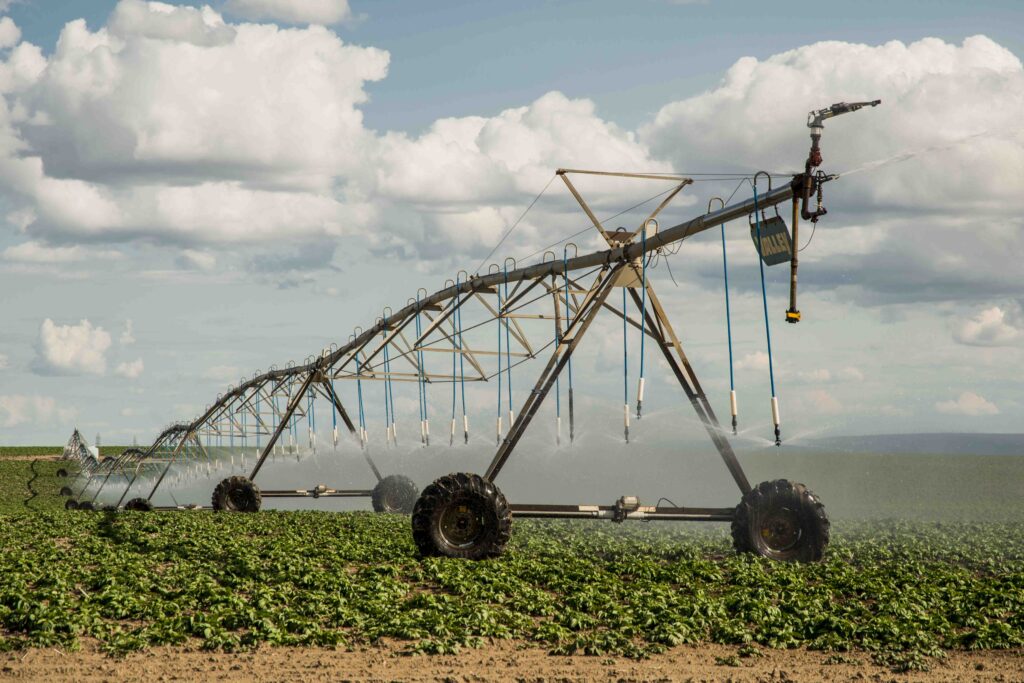
Life depends on water. Global warming is shrinking that resource. Irrigators are rushing in first – before this water crunch hits the Northwest. They want to reserve a big chunk of water for industrial agriculture. Fish and other sensitive native species will suffer from changes in timing of water flows. Also, with climate change, more of our water will come as rain and less as snow. These will hugely impact Oregon and Washington.
NWNL Are you seeing climate impacts already?
BRENT FOSTER Oh yes. Climate change is the key reason the Columbia River is warming. We have hotter air temperature, more sunny days and more solar radiation.
NWNL Is that being documented by government services?
BRENT FOSTER Yes, by EPA and Dept. of Environmental Quality in Oregon. But t just say, “Oh well it’s climate change;” rather than accepting that grazing and dumping are damages to our tributaries that we could fix. Per month, major paper companies dump 100’s of millions of gallons of hot 90º or 100º water. One paper plant can discharge 20 million gallons per day. Every day, a fertilizer plant in eastern Washington dumps 60 million gallons of hot water in the river. That’s a lot of hot water. If a river is already too hot, and every day you still add 60 million gallons of 95º water into it, you are changing the river.
NWNL We’ve talked about climate change, pollution, over-extraction of water, climate change and dams, of course. What is the effect of human sprawl and development along the river. Is there any zoning on building homes or industry near the river?
BRENT FOSTER Oregon and Washington populations are quickly growing, as are those in Idaho, along the Snake River, in British Columbia, and on up to the headwaters where you saw new houses being built on the banks of Lake Columbia and Windemere.
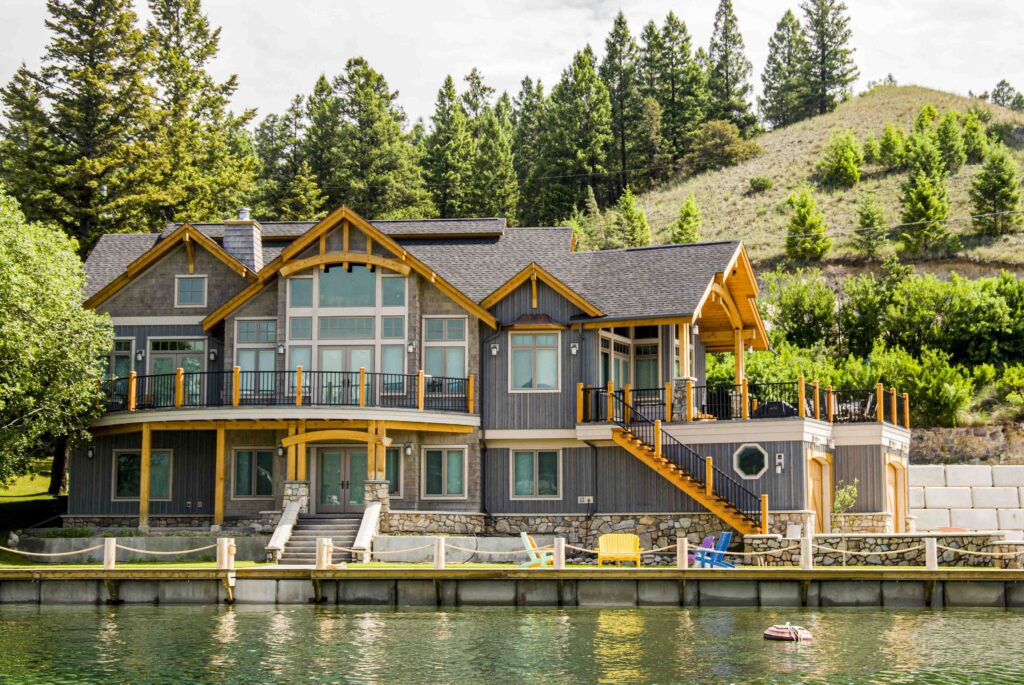
So yes, development is having big impacts on the main stem and on almost all its tributaries. Most zoning is locally determined, so it varies by county and city. In Hood River, thought of as a progressive, Columbia Riverkeeper ran ballot measures to ensure adequate riparian buffers along the Columbia. Some eastern Washington counties are studying shoreline ordinances to decide whether to have 100’-300’ buffers along the river, or just 50’-25’ buffers? Development pressures are huge. Everyone wants to see the river, but that causes serious impacts.
NWNL Coming downriver, I’ve met very committed folks working together to correct such issues via brainstorming, group conversations and other changes that could make a difference. What specific actions do you see from groups or communities you hear about on US rivers, other countries or even Africa?
BRENT FOSTER While there’s a great amount of stewardship on this river, the magnitude of threats are great. We’re fighting 2 coal plants and 2 facilities importing LNG into the Columbia Estuary. For those threats, hundreds of community volunteers sprang up, from local businessmen to commercial and sport anglers, to Native Americans. They are a diverse group working for the common good. I see that spirit from the mouth of the river up to its Lake Columbia headwaters where Friends of Columbia Wetlands are trying to ban jet-ski use in their 180 miles of pristine wetlands. Last year, Citizens for Clean Columbia convened a wonderful 3-day “Rendezvous” in Wenatchee. I’m very encouraged.
When Columbia Riverkeepers started its Water-quality Monitoring Project, various agencies were studying river temperatures in the middle of the river. But those aren’t the habitats that salmon prefer. A false sense that things were a better needed to be addressed. We were blown away by the response of more people than we could use wanting to help. They gathered data and immediately put it to use to help the river.
NWNL Do you feel that positive movement exists both upriver and downriver?
BRENT FOSTER Every Columbia River Basin community has a deep connection with this river. It’s a river that moves people. As big and powerful as it is beautiful, there are still deep connections for those who knew the river when it was a wild. Native American elders remember their loss of Celilo Falls and Kettle Falls when the Dalles and Grand Coulee Dams were built. They suffered deep losses.
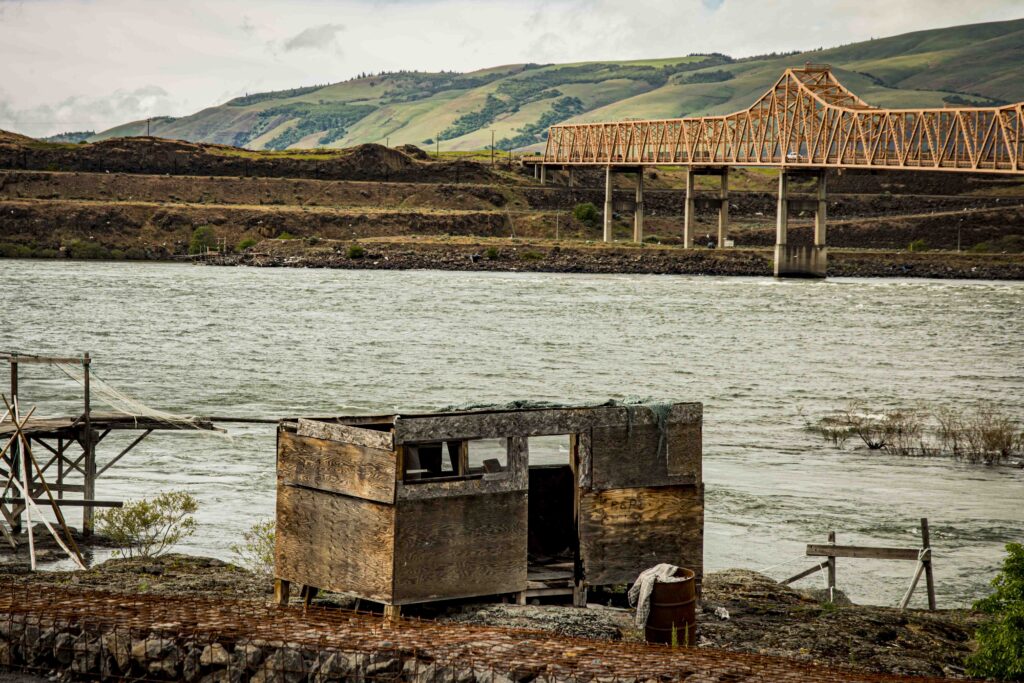
People today want change, so I’m fully confident we can restore the Columbia River. We can do incredible things when we put our mind to it. Will the river again be what it was 200 years ago? Probably not. But we could make radical changes, like having clear water. That’s not asking too much.
NWNL You say you want “clear water” – but that doesn’t necessarily mean “clean”….
BRENT FOSTER I want clear and clean water. Clear water is symbolic and important. The only reason we don’t have a clear river is that people haven’t addressed that yet.
There are murky waters in Portland, above Hanford, above the Snake River’s nutrient-rich waters, and below the agricultural lands that also add nutrients into the water. The lack of clarity is a result of algae and plant mass taking hold in the river. Adding nutrients from agriculture and pollution discharges to very big reservoirs, creates ideal conditions for algae and plant life. They decrease water clarity and oxygen levels because as that material dies and rots, it consumes the oxygen fish need. It is possible to change agriculture and keep it successfully feeding many people without damaging our water resources. But it takes some thought.
NWNL And it will take extra investment, right?
BRENT FOSTER Oh, sure. My long-term vision for the Columbia involves a large-scale investment, similar to what we spent on the Florida Everglades. That would take $8 to $10 billion, which is not big compared to the cost of a war in Iraq. Within 5 to 10 years, we could preserve the Columbia Headwaters and buy riparian lands from farmers that would buffer rivers from agricultural chemicals. Plus, for a very low cost, we could supply technology to significantly lessen toxins from major industrial discharges.
Industries, of course, have free right to use our rivers. But they pay nothing for treating the Columbia River as a big sewer. You or I can’t freely dump our waste or flush our toilets into the river. But, aside from a small permit fee, industry pays only once every 5 years. If we charged them by the gallons or pounds of toxins they spew, we’d force them to start internalizing those costs, now borne by all of us who enjoy the river and its salmon.
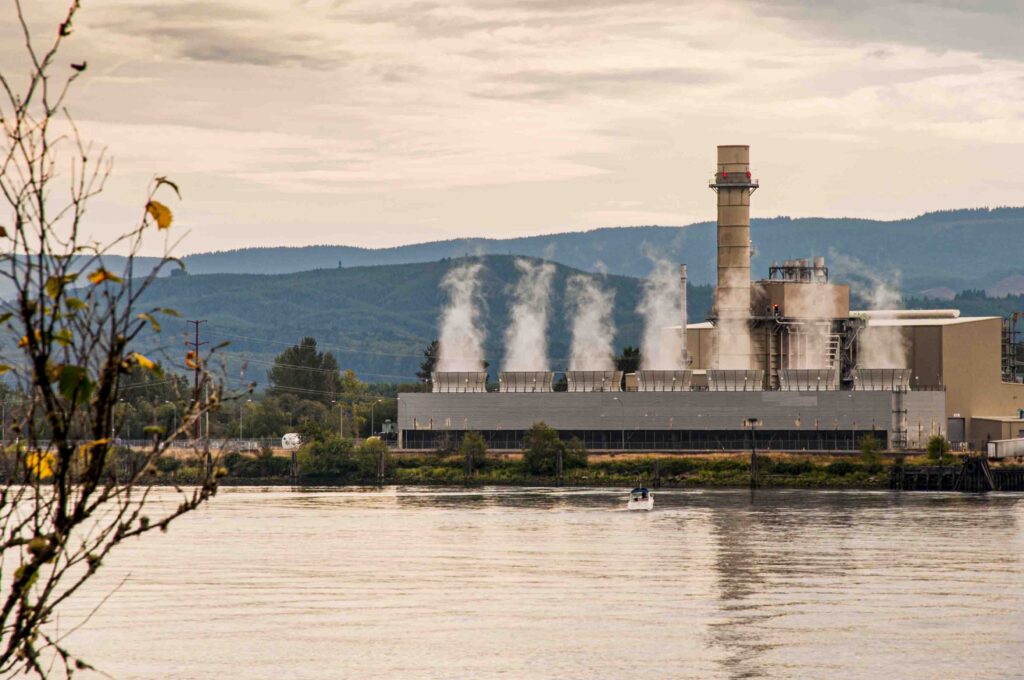
NWNL Are such charges on industry instituted on such users of other rivers?
BRENT FOSTER Not in the U.S. It will take a sea change in attitudes to start incorporating “use taxes” for our riverside industries. But I think we’re seeing a shift. In the last few years, people have started understanding that climate change adversely affects the earth. We are adversely affecting rivers and forests; but we also have the power to restore it. It’s much easier to preserve our environment than to mess it up and then try to fix it – but since that’s our only option, we can and will.
During my years in habitat restoration, I’ve seen areas completely devoid of any biological value quickly turn into songbird breeding sights, rich with bumble bees, insects and butterflies. Some ecosystems take much longer than others to repair; but fortunately, river ecosystems can respond very quickly. All experts predicting recovery from major dam removals have undersold how quickly that our river would recover.
NWNL Yesterday on Hood River, I walked out on a new spit pushing into the Columbia, formed by a silt-carrying storm six months ago. Now grass is already growing on this spit out in the middle of the Columbia. How quickly that vegetation came up!
BRENT FOSTER Yes. Rivers have a natural ability to restore themselves – but we need to give them the space to do it.
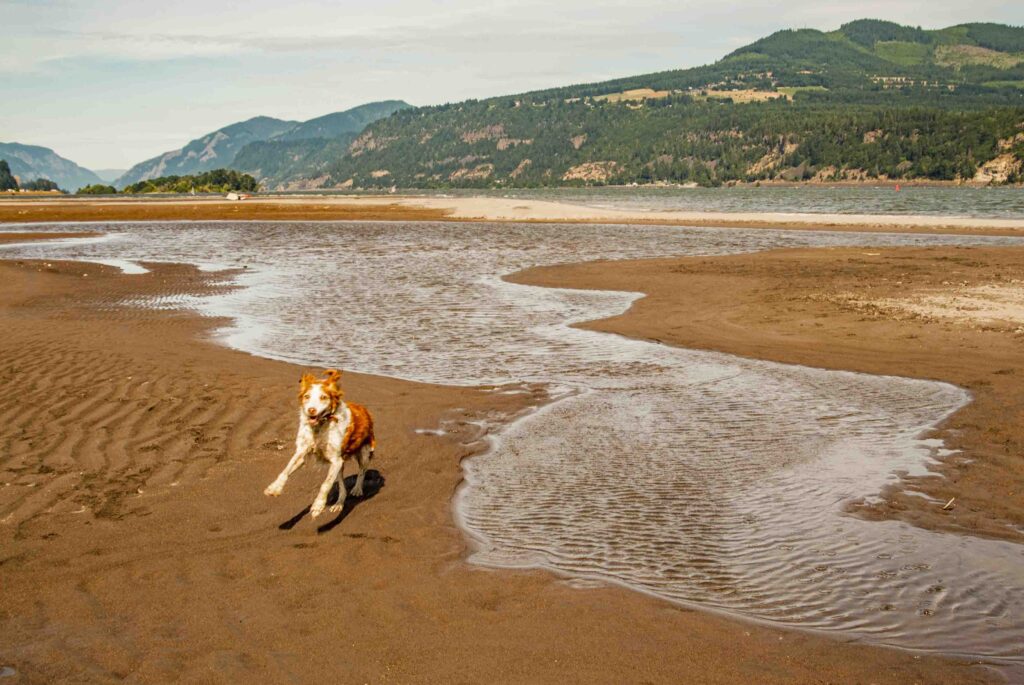
NWNL You discuss needing $8-10 billion to restore this river. What is now being spent in Hanford each year to clean up?
BRENT FOSTER Hanford’s remediation operation costs about $2 billion yearly.
NWNL That’s one quarter of the amount you just mentioned.
BRENT FOSTER Right, but much of Hanford’s money has very little to do with the river. The need to fund Hanford is huge. It’s considered the most contaminated site in North America. Perhaps it’s the world’s most contaminated site, other than Chernobyl. We built the uranium bomb there that was dropped on Nagasaki; and now we’ll pay the cost of that for a long time.
Unfortunately, much of that $2 billion yearly spent on cleaning up radioactive waste is swallowed up by big contractors who show little interest in solving this problem. It’s a huge cash cow, with a massive industry around it. That doesn’t solve the salmon problem at all.
We could and should spend $5 billion a year to get Hanford cleaned up, because it’s only going to get more expensive. It’s not cheap; but Portland drinks what comes from the Columbia. If we spent $5 billion annually, we’d get back returns of spending such big-dollar amounts. Rivers that aren’t intact squander water.
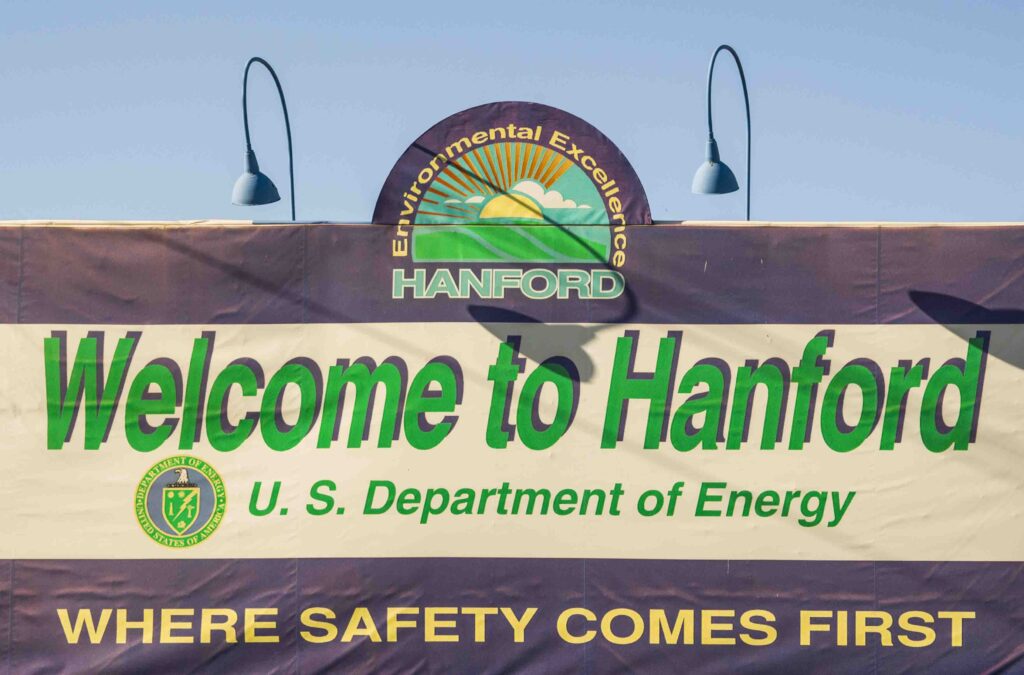
NWNL Columbia Riverkeeper has the chance to play a big role in bringing together industry and environmentalists. How are you, as Columbia Riverkeeper, approaching this challenge? Are there successful models used by other Riverkeepers? Do you work with other riverkeepers, problem-solve together or convene in search of solutions?
BRENT FOSTER Columbia Riverkeeper’s vision is very clear: to support a restored Columbia River. We want clean water from the headwaters down to the mouth of the river. We want to see healthy and fish-able salmon populations that can support tribal and non-tribal fishermen.
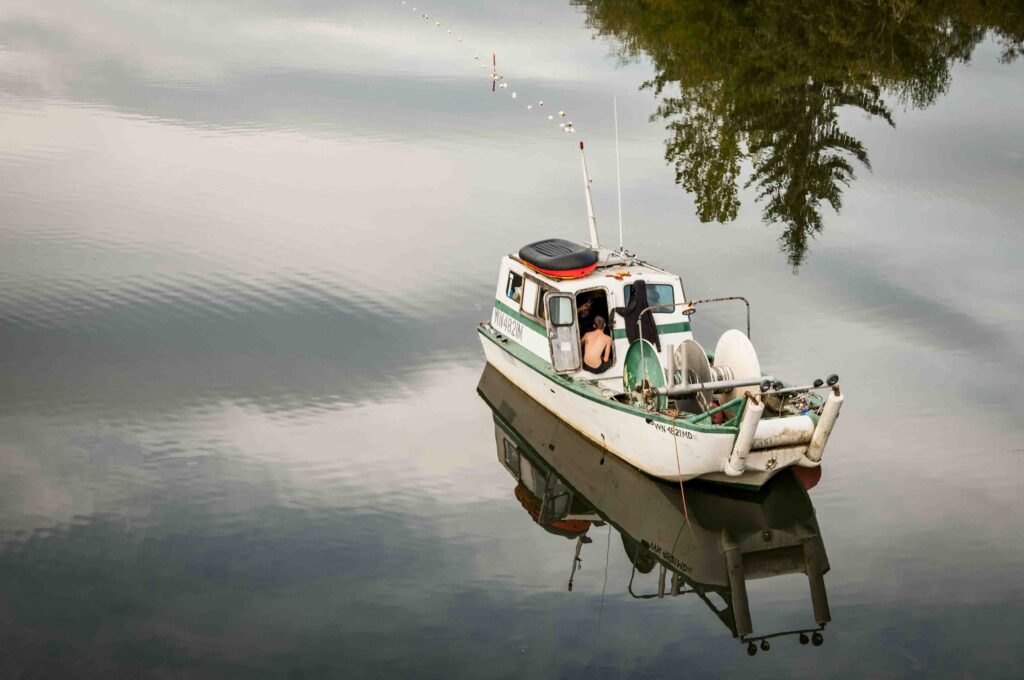
We want to see people proud of having restored a place where they can take their kids to swim. All the time, people call to ask, “Is it safe for my kids to swim in the river?” People should be able to swim in the river and feel good about it.
Our approach is a mix of different tactics. First – we don’t touch litigation, it’s too controversial. But we do work on legislature and with local governments. In this 1,243-mile river, we’ve got to use all the tactics that work for a specific situation.
We’ve ran three ballot initiatives last year and won them all. We brought 17 lawsuits last year that represent enforcement litigation. But it’s just as important to sit down, compromise and negotiate with people and municipalities. We just compromised to reach a landmark toxic-reduction bill with Oregon municipalities. We’re trying to connect more with others, but there’s no Canadian Riverkeeper on the upper Columbia. However, when we have our annual Riverkeepers Conference, I sit in with the Canadian Riverkeepers who work on other issues since they have different laws.
Until three years ago, I didn’t know what Riverkeepers were. Now, as our capacity grows, Riverkeepers is critical to allowing me to meet Canadian stewards. This is a big step forward, which hasn’t happened in the last 30 years.
NWNL It is great to see a river binding together two Pacific Northwest countries.
BRENT FOSTER Yes it is! At a Canada-US meeting in Wenatchee WA, Kindy Gosel and others from the Canadian headwaters connected us with activists like Cheryl Johnson and Ted Messing from the estuary in Astoria. That was both ends of the river meeting in the middle of the river for the first time. No one I’ve talked to has heard about that type of meeting happening among grassroots activists.
That was empowering, so I think we’re going to do it again this year since now we’ve started considering a collective vision for the river. We’ve even contemplating doing national legislation in both countries at the same time – perhaps our pushing a Columbia River clean-water bill here as they’re pushing one in Canada. That thought is unique, exciting and potentially very helpful.
NWNL Upstream, downstream! You are bringing it all together, working jointly with upstream and Canadian scientists, biologists, people collecting critical data.
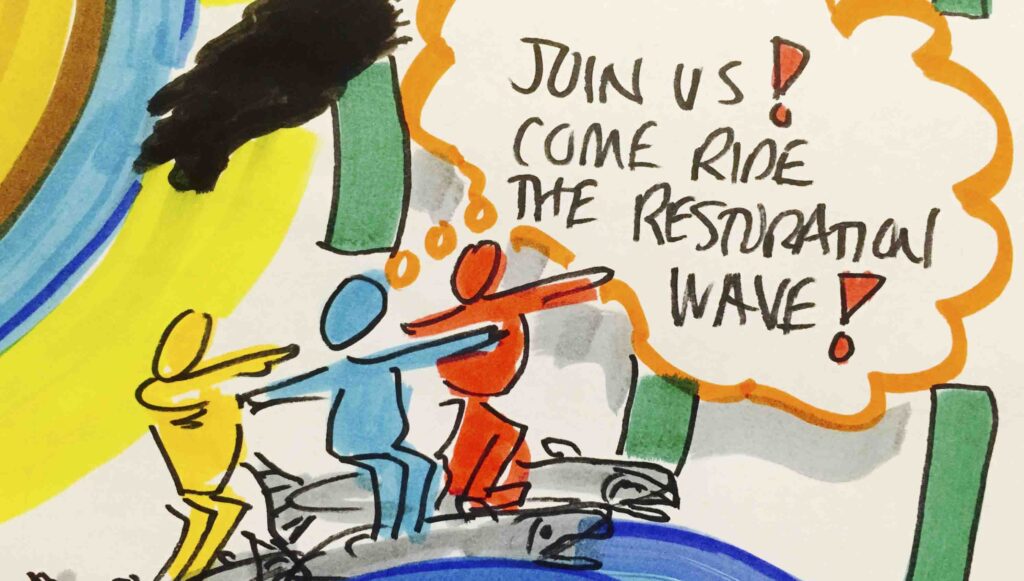
BRENT FOSTER It’s hugely important to do so. In my mind, an environmental conservation group must be up to date on the science needed to support our efforts – such as published papers showing high concentrations of mercury in sturgeons’ reproductive organs. My background is in science and biology, and basically my co-worker is our science advisor. Our work with scientists in state, environmental, and fisheries agencies and other departments is critical.
One inspiration for my becoming a lawyer was seeing how lawyers struggle to explain the relevance of science to a judge. I remember a lawyer unable to articulate the importance of native grassland. I sat there thinking, “It’s important because this native grass has a year-round root system that supports small ground mammals that feed on it all year. That, in turn, stabilizes their population and thus supports larger predatory bird populations. But all this lawyer could say was, “Well, they’re very rare.”
I realized that being be able to explain a biological concept in plain English would support the ability of the judge to grasp the issue. When I see a judge rule for environmental plaintiffs, they may have facts and law on their side, but they also need to grasp a little bit of the complexity and wonder of the science involved.
NWNL Well, it seems you are knee-deep in science now!
BRENT FOSTER We spend a lot of time designing water-quality and toxicity studies so they’re scientifically rigorous, quality-controlled and provide assurance. When we started sampling water quality, we had to determine the quality we wanted for our data. The higher the quality, the more effort is needed for verification. We decided to go for AA data so it would be as good as if the agencies did it themselves. That was our standard, and now agencies rate all our data AA. That is important. To merge grassroots education, activism and legal enforcement, you need science to direct you and backup your efforts.
NWNL So, it’s a three-legged stool?
BRENT FOSTER Yes, you need those 3 components, plus a legislative component. Unless you can say the laws now on the books are all we need, then we need to start thinking how to make laws to address our current problems, including non-point source pollutions that are a huge problem.
NWNL Riverkeepers seems to be an incredible network of watershed stewards.
BRENT FOSTER Well, the Waterkeeper Alliance is comprised of 150+ Riverkeeper groups. When at their in New Orleans conference, I spent time with the Riverkeeper from Hann Bay, Senegal – Africa’s first Riverkeeper group. This group is dedicated to protecting the big coastal Hann Bay. I also met Riverkeepers from China, Columbia and the Amazon. This is a great support network allowing new river keeper groups to learn from those that have been around longer, like the Hudson Riverkeeper.
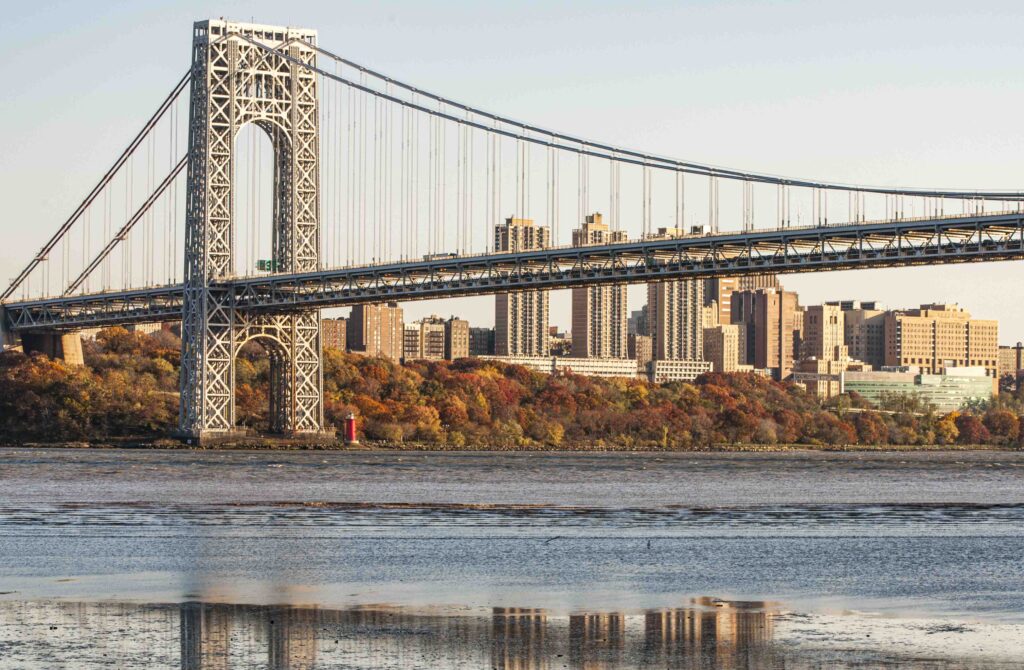
I’m now working with the Cook Inletkeeper in Alaska on a potential lawsuit like a lawsuit I earlier worked on. Waterkeepers is growing very fast because the model works so well, since it’s based on having people on the river. You just can’t be sitting in an office working on these river issues. You need to spend time on the river, know the people, know the places and have a capacity for legal enforcement, and be able to compromise and collaborate when possible.
When going up against the biggest corporations in the world that can make millions of dollars from the status quo, you’ve must use the courts, because you can’t rely on campaign finances, local legislators, federal legislature or the press. Many of those positions have been bought and paid for. While imperfect, the courts are more immune to corporate pressure than other branches of government.
NWNL When was Waterkeepers Alliance launched?
BRENT FOSTER The Waterkeeper Alliance formed after many Riverkeepers were established. Hudson Riverkeeper, the first, was formed by blue-collar workers and fishermen tired of seeing the Hudson completely abused. With the help of Bobby Kennedy Jr., they were able to hold the responsible companies accountable.
Bobby Kennedy frequently says the connection between polluters and corporations is inseparable, since they’ve been given so much power. They have all the rights, and their responsibilities are limited. They even control campaign finance. Many days I think I should just stop all my environmental work and just focus on campaign finance reform. We can succeed in changing the vision, direction and values toward protecting our watersheds. Yet without campaign finance reform, it’s like running a marathon with a broken leg. You might finish, but it’d be much easier without a broken leg. Likewise, our intertwining conservation efforts and fundamental reforms in our government are hampered by big corporations being protected by First Amendment free speech rights. Buying politicians is crazy and fixing it is not easy. But Riverkeepers must work on it. I think there’s good support for reforming corporate power.
NWNL What is your dream for the Columbia, and for the great rivers of the world?
BRENT FOSTER As a foundation, Waterkeeper Alliance needs an engaged and active population caring about the river, seeing the river as theirs, holding responsibility for it as well as loving it. Despite the litany of reasons people use to say why we can’t bring the river back, we must say, “Thank you, but we’re going to bring it back.” One of my favorite times to get into a dispute is when someone says it’s already done, the decision’s been made, or there’s nothing we can do about it at this point. Those are the kind remarks people make regarding restoring rivers. But, whether it’s the Columbia, the Hudson or whatever, we can pollute it – and we have the power to turn off that tap. We can restore a stream. We’re learning. The idea of bringing back a stream is so new; but it’s very possible.
One of my projects in college was regarding an Army Corps of Engineers drainage, which had been a straight ditch for 30 years, with some willow and cottonwood plantings. When you go there now, hundreds of songbirds are under tree canopies after a couple of years of work with no funding. When we started, we didn’t even have permits!
So, I’m optimistic about the power to bring back rivers. My vision sees a clean river that’s safe to swim in, full of self-sustaining fish safe to eat and a host of historic species. I tell people down in Astoria, the Canadian Columbia River Basin still has grey wolves drink and grizzly bears wading into the river. I love the idea of the connectedness in thinking that we have hair of grizzly bears out on the river.
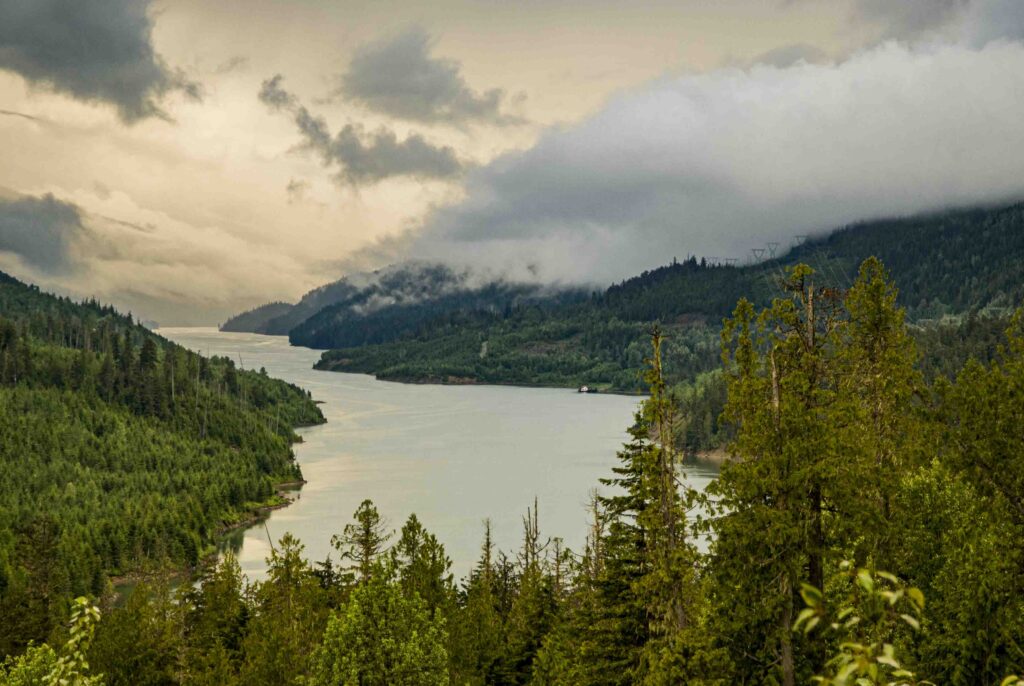
NWNL The downstream Columbia needs upstream decaying trees to float down this river so their nutrients enter the estuary that attracts spawning salmon to continue upriver. That power of the Columbia plume in the Pacific Ocean fascinates me.
BRENT FOSTER The Columbia plume is the largest hydrologic feature between Canada and Mexico. Its southern end stretches down to Monterrey Bay, California, in the summer. It invites the salmon to come inland to feed and it has an increased productivity above that already in the ocean. It’s hugely dynamic.
NWNL What do you know about the quality of that plume and the nearby dead zones?
BRENT FOSTER The official position on the dead zones is the Columbia plume has nothing to do with them. But if you overlay a map of the dead zone on a map of the Columbia plume, they match almost perfectly. We’ve been quietly working on this issue. About 95% percent of all dead zones in the world are related to a major river system with “over-nutriented” water. This further supports suspicions that the plume plays a role in forming those dead zones.
Nitrogen is certainly a big issue. In many river systems their plumes are a main driver in forming dead zones, like the Mississippi in the Gulf of Mexico. That may not be happening off Oregon; and there could be various factors coming into play. Yet, we know there’s a huge amount of biomass, algae and plant life from the Columbia’s large, flat-water reservoirs. That vegetation dies when it reaches saltwater. It drops to the ocean floor and then rots. So, multiple factors come into play.
We’re not at the point of saying the Columbia is causing the Oregon-Washington dead zone. But it’s unbelievable that there’s no research on that possible linkage. Thus far, it’s been systematically dismissed without adequate basis, as have been the very high iron levels in the Columbia being a major nutrient stimulating growth causing dead zones. We know that all the tributaries, including the Snake and Spokane Rivers, are causing major nutrient problems. If all the tributaries, or at least many, have significant nutrient problems, and the Columbia has a nutrient problem with algae more than a foot deep, then there’s good reason to think that the Columbia contributes to the dead zones.
NWNL I’ve heard scientists lament that trees aren’t falling into the river anymore which means they are not decomposing into the river to eventually enrich that plume as the river enters the Pacific.
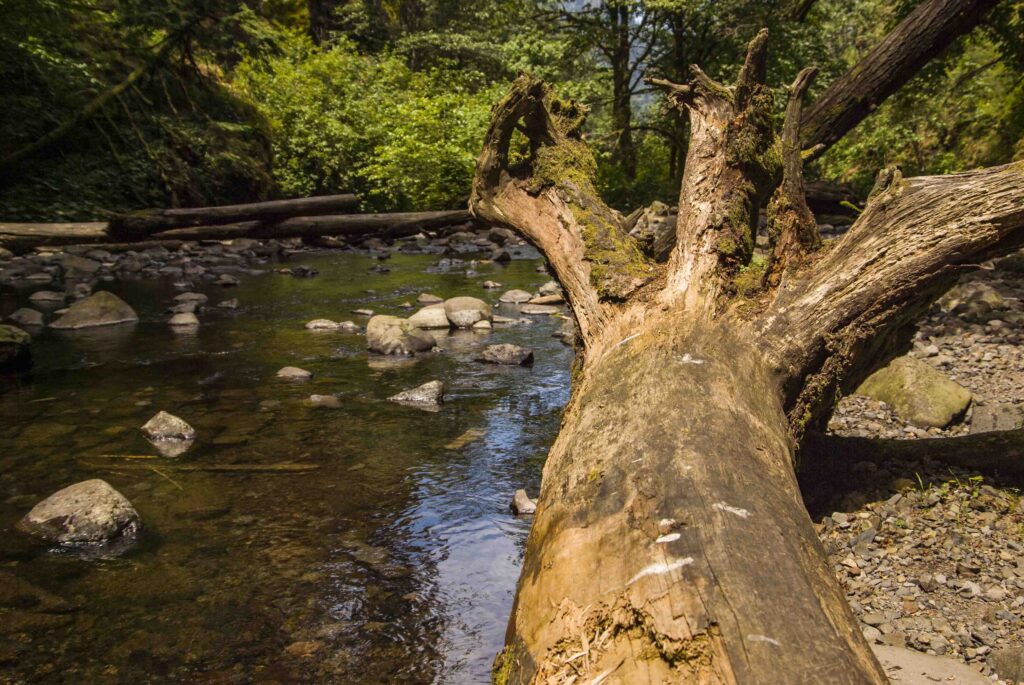
BRENT FOSTER Well, trees have many very important roles in the river, such as creating habitat structure for insects that salmon depend on. But like anything, species extinction is a natural process. The problem is the rate at which it happens. Nutrients have always moved through the Columbia system. I don’t know how many nutrients a tree puts off while moving. Actually, the movement of salmon is the huge nutrient that enriches the Columbia ecosystems.
NWNL Right, But the process of trees rotting, floating down and entering that ocean plume is critical in supporting salmon seeking those nutrients while they are in Pacific waters. They say, “Oh, oh, I smell trees…. I want to go back up to British Columbia again!”
BRENT FOSTER I’ve heard that most of the signals for salmon to their return to their native stream are based on traces of sediment more than that of trees floating downstream.
NWNL But rotting trees create sediment….
BRENT FOSTER Yes, they can; and it’s not entirely clear what marks salmon use.
NWNL There are many Superfund Sites in the Columbia River Basin that have grabbed your attention, including those in the Coeur d’Alene Basin, Midnight Mine on the Spokane, and the Portland Superfund.
BRENT FOSTER Yes, the whole Spokane River is listed for its range of toxins from mining days to Teck Cominco mining contaminants just north of the Canadian border. You can stand on the Upper Columbia’s black sand beaches; take a magnet to the sand; and iron and other heavy metals will jump onto your magnet because that black sand is mining slag. That will take a long time to work its way through the river’s system. It’s all backed up now behind Grand Coulee Dam.
If you pulled the plug on Grand Coulee Dam, there’d be a lot of sediment. That’s where dam removal gets very expensive! How do you get rid of polluted sediment? There are real challenges. But I see opportunity for progress and see streams starting to get restored….
NWNL I sense you are encouraged there is a powerful force behind your vision.
BRENT FOSTER Yes. Twenty years ago, removing the Marmot Dam would have just felt fictitious. Now, hundreds of dams have come down across the country, and thousands more are slated to come out. So, some of the biggest high-profile dams – the Savage Rapids dam in southern Oregon, the Elwha up in the Olympic Peninsula, and other big dams – are coming out. I think that’s exciting. We have too many dams. We need some, but we have way too many. There are good reasons they’re going out now.
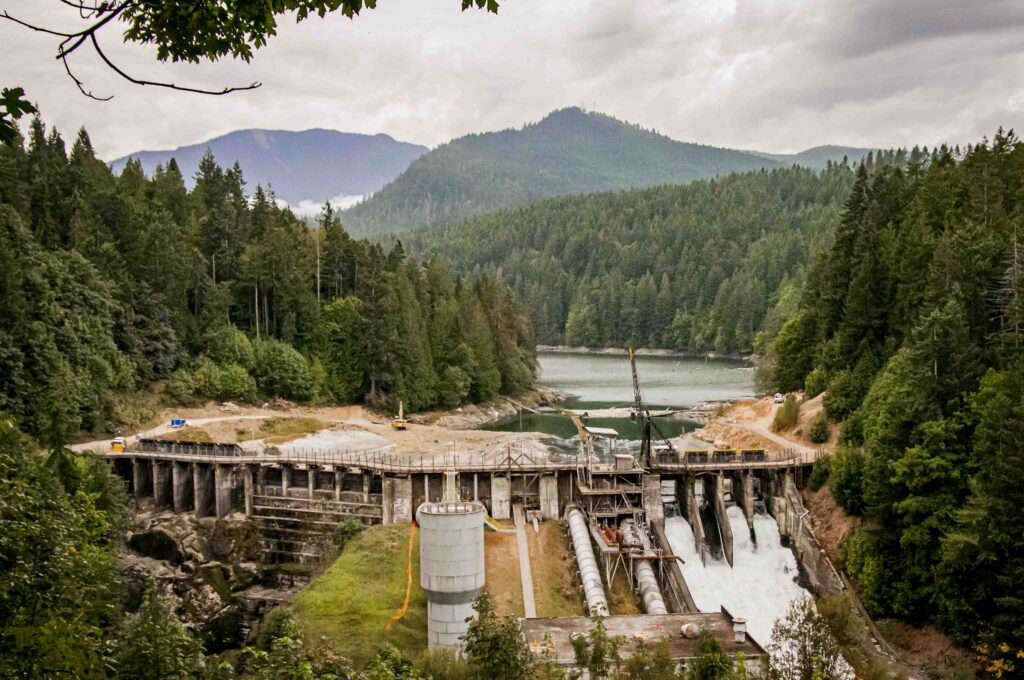
NWNL You mentioned an international meeting to support the younger groups?
BRENT FOSTER Waterkeeper Alliance’s international structure has well-funded groups in the United States, Canada and other places that support Waterkeeper groups in developing countries, such as the Hann Baykeeper and several groups in Mexico. Somebody just donated $20,000 to the Chinese Riverkeepers so they can get their first boat. This is exciting. As well, Columbia Riverkeepers board approved our giving up to 1% of our yearly gross income (between $3,000 to $5,000 ) to Riverkeepers in developing countries.
Waterkeepers’ grant program gives 1% of their $1million a year budget. So, that $10,000 significantly increases the capacity of us all. So, what we’re seeing is it’s not just, “The Columbia is my river, and I don’t care about anything else” – but it’s a much bigger connection.
When I was down in Baja, I met one of the Mexican Waterkeepers. The same grey whales whose juvenile and nursery habitats he protects, swim right through the Columbia River plume. So, even though we’re separated by thousands of miles, there’s that direct connection between us.
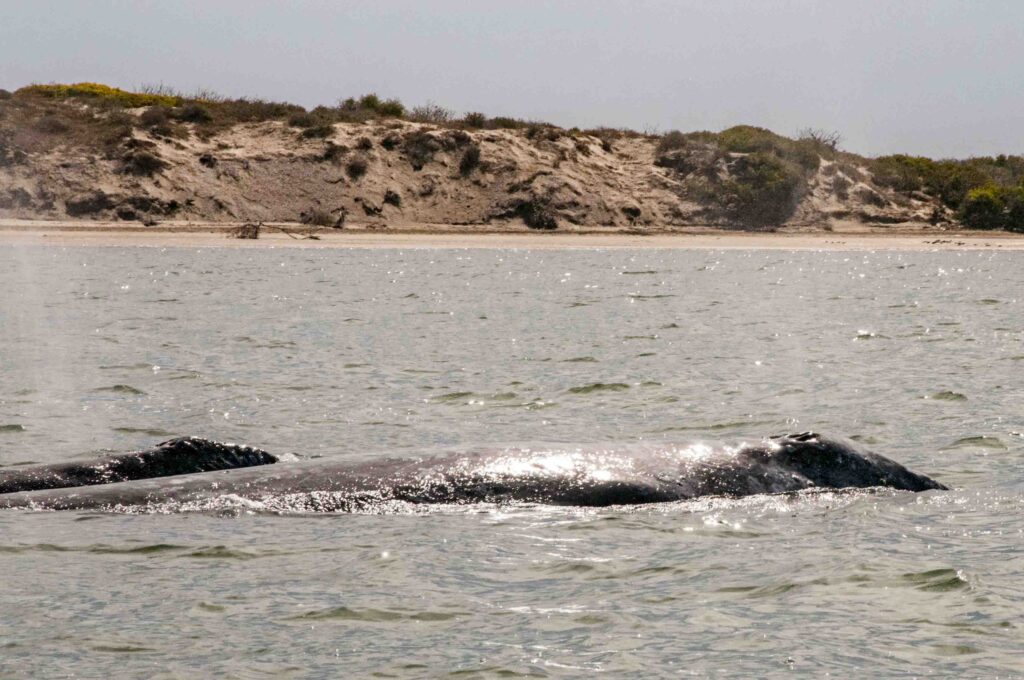
BRENT FOSTER It’s exciting to be a part of the Waterkeeper movement that understands the bigger picture. It’s not just NIMBY [Not In My Back Yard], it’s that we have to cleanse and protect everybody’s river and really create an international river movement. That’s the goal of Waterkeeper Alliance.
NWNL That’s a great conclusion for this interview! Thank you, Brent; and good luck with all you do to protect this dynamic and powerful Columbia River system.
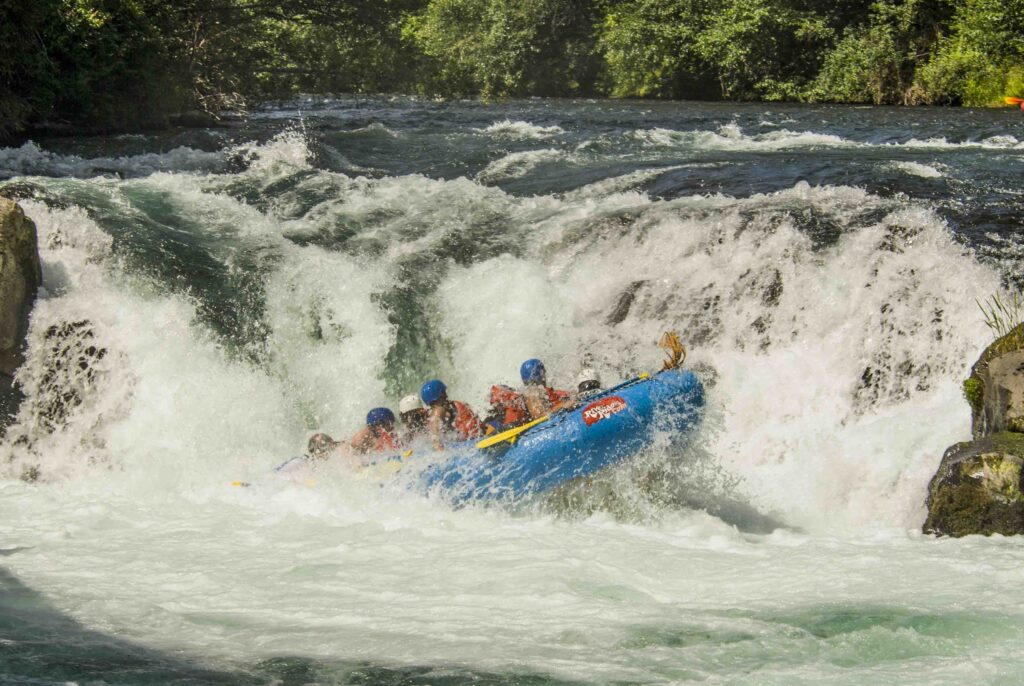
Posted by NWNL on December 7, 2023.
Transcription edited and condensed for clarity by Alison M. Jones.
All images © Alison M. Jones, unless otherwise noted. All rights reserved.
